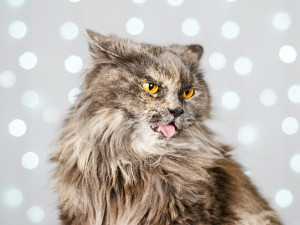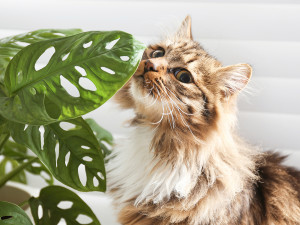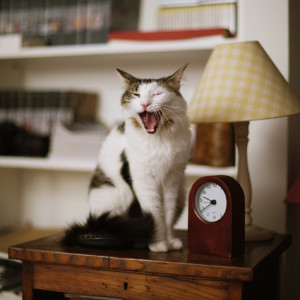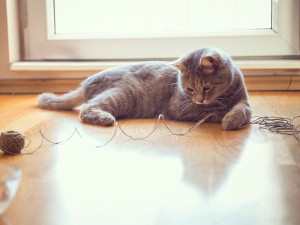What to Do if Your Cat Is Vomiting White Foam: Precautions and Care
It could be caused by a totally harmless reason, so don’t panic.

Share Article
In This Article:
Why is My Cat Vomiting White Foam?opens in new tab What Precautions Should I Take?opens in new tab How to Care for a Cat Vomiting White Foamopens in new tab When Should You Call the Vet?opens in new tab
As a cat parent, you know that occasional vomiting can happen and just hope that you don’t discover the puke with your bare foot. The first bout of vomiting may not seem serious — perhaps your cat skipped a meal or drank too much water too quickly. However, persistent or frequent vomiting of white foam may indicate underlying health issues that need attention.
Understanding the causes and knowing how to respond can help keep your furry friend healthy and comfortable.
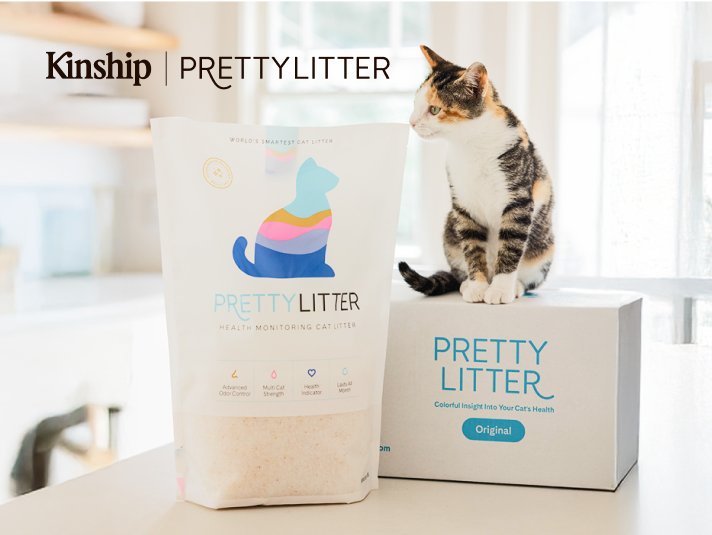
Save on the litter with color-changing tech that helps you better care for your cat.
Why is my cat vomiting white foam?
There are many reasons why cats puke and many different types of cat vomit. When a cat vomits and only brings up foam, it’s usually because there’s nothing else in their stomach. The occasional white, foamy vomit may not seem worrisome, but it’s important to understand what could be causing it. Possible causes of a cat vomiting foam include:
Hunger or empty stomach
Your cat is getting your attention and demanding food, way before their normal meal time. They meow. They knock stuff off the night stand. Then they puke on the book you’ve been reading. Is your cat just being a jerk? Kinda, but not totally. Cats can get so hungry that they get nauseous and vomit, a syndrome called bilious vomiting.
Bilious vomiting occurs when pets vomit after prolonged periods of not eating. The typical time this occurs is early in the morning after having no food overnight. The vomiting is thought to be the result of gastroduodenal reflux, which irritates the lining of the stomach and causes vomiting. Bilious vomiting is much more common in dogs than in cats.
Hairballs
Cats like to keep themselves clean, and constant grooming can lead to accidental ingestion of hair. A wad of fur in a cat’s stomach can cause stomach irritation or interfere with digestion until the body decides the best course of action is to get rid of it. When a cat pukes up a hairball, a small amount of white foam may come up with it.
Upset stomach
Cats can get upset stomachs from time to time, especially if they’re curious nibblers or like to hunt. Cats can experience stomach upset if they ingest items commonly found around the house like people food, trash, houseplants, or insects.
Mild stomach upset (gastritis) is usually temporary and will pass on its own, but cat parents should keep a watchful eye to make sure the symptoms are actually resolving.
Underlying health issues
Health issues can cause nausea, poor appetite, and vomiting in cats. Organ dysfunction, like kidney or liver disease, can leave cats feeling unwell enough to cause vomiting — often clear foam if they’re also not eating well. Hormonal diseases like hyperthyroidism and diabetes can lead to vomiting, too.
Intestinal parasites
Intestinal parasites are a common cause of appetite changes, diarrhea, and vomiting in cats. In cases of cats with a heavy worm burden, adult worms may be present in the foamy vomit.
Common intestinal parasites include roundworms, hookworms, tapeworms, Coccidia, and Giardia. Kittens, outdoor cats, cats in multi-pet homes, and cats on a raw diet have a higher risk of becoming infected with intestinal parasites.
Intestinal disease
Repeated episodes of vomiting white foam may be a sign of underlying intestinal disease in cats. Inflammatory bowel disease (IBD) in cats causes chronic inflammation of the gut, which can result in loose stool, vomiting, and weight loss. Other intestinal issues include food intolerance and cancer can be a cause of vomiting foam in cats.
Foreign bodies
Vomiting is one of the most common symptoms of a gastrointestinal foreign body in catsopens in new tab. Some cats would never dream of eating something that’s not food, but others relish tasting everything in their environment. Foreign objects in the GI tract will disrupt digestion and block the passage of food through the intestines.
When there is an obstruction present, the fluid in the stomach will be vomited up if it can’t pass on to the small intestines. These cats may also vomit after eating. Vomit due to foreign body can vary in appearance — it can be yellow, green, clear, or foamy.
What precautions should I take?
If your cat is vomiting white foam, a few immediate precautions can prevent the problem from worsening:
Monitor their behavior
Vomiting white foam may be due to a minor issue that will soon resolve, but it can also be an early sign of something more serious. If your cat starts vomiting, keep a close eye on them and watch for signs that your cat is feeling unwell. Signs to watch for include:
Lethargy
Poor appetite
Pain
Diarrhea
Change in litter box habits
Check for dehydration
Vomiting — even if it’s just foam — is a form of water loss. Multiple episodes of vomiting can lead to dehydration, which can make your cat feel even worse. Dehydration signs in cats include lethargy, poor appetite, dry gums, and delayed skin tent.
Checking your cat’s skin tent is an easy way to check for dehydration at home. To check your cat’s skin tent, gently lift the skin between the shoulder blades. If your cat is hydrated, the skin should snap back almost immediately. A delay could indicate dehydration. If the skin remains tented, that’s an indication of severe dehydration and a sign to get your cat to the vet.
Identify and remove irritants
Take a good look around your home for potential irritants that your cat might get into. Toxic plants are an obvious no-go, but even “safe” plants can cause gastritis and vomiting if your cat nibbles on them. Make sure trash cans are covered. And this may sound oddly specific, but keep your hair ties out of our cat’s reach, too. I’ve removed too many hair ties from cat stomachs to not issue a warning.
How to care for a cat vomiting white foam
If your cat is vomiting repeatedly or has additional symptoms, trying home remedies for cat vomiting is not the best course of action — seek veterinary help. But if your cat puked foam once and you're waiting and watching to determine next steps, there are some simple measures you can take.
Provide fresh water
Make sure your cat has easy access to plenty of fresh water so that they can take in enough water to stay hydrated.
Stick to a consistent diet
If your cat vomits, you may be tempted to offer a different food to help their upset stomach. But suddenly changing your cat’s food can wreak even more havoc on your cat’s digestive system. If you’re concerned that your cat is having a poor response to their current diet, talk to your vet about possible causes and solutions.
Reduce hairballs
If your cat is constantly puking hairballs surrounded by white foam, you may want to focus on strategies to reduce hairballs. First, work with your vet to make sure that your cat isn’t over-grooming due to underlying skin issues like infection, parasites, or allergies. If skin disease isn’t a concern, regular brushing can reduce the amount of fur your cat swallows during grooming. Long-term, your vet can recommend dietary supplements to help you cat pass ingested fur more easily.
When should you call the vet?
While a single episode of vomiting isn’t a reason to rush to the vet, persistent or severe symptoms warrant a veterinarian visit. Signs that your vomiting cat needs to see a vet include:
Persistent vomiting
Persistent gagging
Vomiting bile or green fluid
Vomiting blood
Lethargy
Weakness
Abdominal pain
Diarrhea
Changes in appetite
Changes in litter box habits
Dehydration
Bottom line
Cats may vomit white foam for reasons ranging from mild digestive upset to more serious health problems like IBD, kidney disease, or foreign body. Identifying the root cause early and consulting a veterinarian if the symptoms persist are key steps to ensure your cat’s well-being.
References
Batchelor, Daniel J., et al. “Mechanisms, Causes, Investigation and Management of Vomiting Disorders in Cats: A Literature Review.” Journal of Feline Medicine and Surgery, vol. 15, no. 4, 1 Apr. 2013, pp. 237–265, pubmed.ncbi.nlm.nih.gov/23403690/opens in new tab, https://doi.org/10.1177/1098612X12473466opens in new tab.
Cohn, Leah, and Etienne Cote. Cote's Clinical veterinary Advisor: Dogs and Cats - E-Book (4th Edition). Elsevier - OHCE, 2019.
Ferguson, Leah et al. “Bilious Vomiting Syndrome in Dogs: Retrospective Study of 20 Cases (2002-2012).” Journal of the American Animal Hospital Association vol. 52,3 (2016): 157-61. doi:10.5326/JAAHA-MS-6300opens in new tab
Iturbe Cossío, Tamara Libertad et al. “Risk factors associated with cat parasites in a feline medical center.” JFMS open reports vol. 7,2 20551169211033183. 18 Aug. 2021, doi:10.1177/20551169211033183opens in new tab
Zoran, Debra L. “Managing Vomiting in Cats (Proceedings).” DVM 360, Oct. 2011, www.dvm360.com/view/managing-vomiting-cats-proceedingsopens in new tab. Accessed 13 May 2025.

Dr. Alycia Washington, DVM, MS
Alycia Washington, DVM, is a small animal emergency veterinarian based in North Carolina. She works as a relief veterinarianopens in new tab and provides services to numerous emergency and specialty hospitals. She also works as a veterinary writer with a focus on educating pet owners.
Related articles
Why Does My Cat Throw Up After Eating?
That doesn’t seem normal...
![cat sniffing a plant]()
Household Plants That Are Toxic to Cats
These plants might be beautiful, but they’re deadly to feline foragers.
Why Is My Cat Throwing Up Undigested Food?
And how you can prevent it.
![White-and-brown cat sitting on a side table by a lamp with their mouth open, gagging]()
Your Cat Is Gagging. Should You Panic?
It’s not always an emergency — but it could be.
![Beautiful playful tabby cat lying on the living room floor, playing with a ball of string.]()
How to Treat Intestinal Blockages in Cats
If you see a string sticking out from, uh, behind, never, ever, ever pull on it.
![cat biting person's hand]()
How to Make Your Cat’s Oral Care as Stress-Free as Possible
Your cat’s oral hygiene is essential to their health. Take things slow and figure out what works best for your kitty’s pearly whites.
